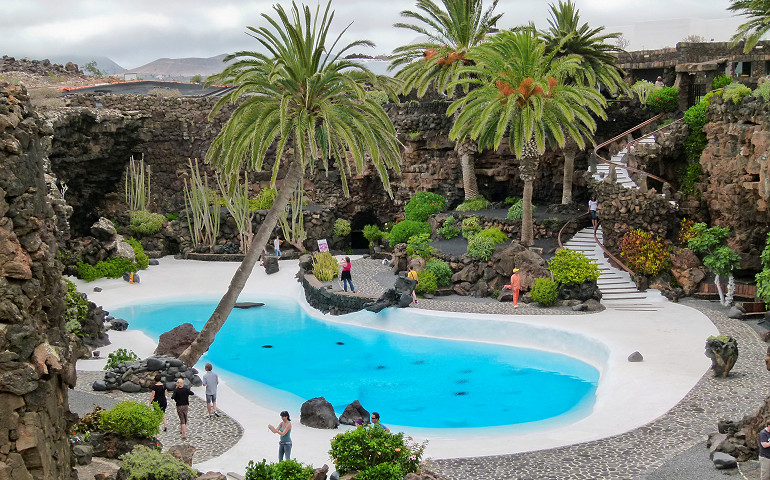Managing your booking with Club Europe couldn’t be easier.
Click below for details of our user-friendly client portal.
Find out moreTel: +44 208 772 6446



“Club Europe offer a great personal service, helpful and always proactive and patient. They are really positive and professional.”
Alexandra, Head of Physics, Alleyn’s School London
“I have had excellent service as always. We used the sites as sources of historical evidence to aid GCSE performance. All aspects of the trip...”
Patrick, History Teacher, Hampshire

A truly unique setting for a field studies trip, on this ‘Island of the 100 Volcanoes’ your students will be able study plate tectonics and volcanology. They will learn about the challenges of living in this environment and study how the natural landscape can be preserved and sustained. They can: witness the spectacular volcanic features of Timanfaya National Park; wander through the fascinating lava caves of Jameos del Agua; or visit the magnificent former studio-home of artist and architect César Manrique.
The island’s incredible range of natural wonders make it ideal for GCSE and A Level students alike, and, thanks to its great climate, can be visited all year round.
We can provide a specialist Geography tutor for your trip.
Day 1
Arrive at your accommodation centre. Time to relax, take a swim. Dinner at the hotel.
Day 2
A full day in the North of the island. Visit the unique caverns and volcanic lava tubes at the Jameos del Agua. Then visit the fascinating underground caves at the Cueva de los Verdes.
Day 3
A full day in the South of the island. Spend a day at the spectacular Timanfaya National Park. Enjoy a camel ride over the dunes, watch volcanic demonstrations and take a guided tour across this dramatically beautiful park, which features lava formations and volcanic craters
Day 4
Enjoy a submarine safari on board a real submarine in which you’ll dive to over 30m below the waters of the Atlantic Ocean. The afternoon free to enjoy the hotel before departing for the airport.
Take a guided tour and watch demonstrations in this dramatically beautiful park, the region’s only national park that is geological in nature. The Park is the result of volcanic eruptions from 1720-1736, and in 1824 and features include lava formations, volcanic craters, volcanic cones and domes as well as geothermal activity.
Highlights include a camel ride over the volcanic dunes and a chance to explore the rugged coastline at the Salt Flats of Janubio and the rocky inlet of Los Hervideros.

Home to the Green Lagoon known as El Charco de los Clicos that is connected to the sea through underground cracks. It is green because of the many plant organisms in the water. This area is of special interest to geologists because of the olivine gemstone that is found here.

Photo@Alessia Cocconi on Unsplash
Unique caverns and volcanic lava tubes on a site that also features a saltwater lake, an auditorium built into a cave and a restaurant.
Spectacularly embellished by Cesar Manrique, the island’s famous local artist, there are both natural and man-made swimming pools.
The indigenous tiny blind albino crabs can be seen in the lake and also on site is the 'House of Volcanoes’ with exhibits on volcanology in the region.

Part of the same volcanic tunnel as Jameos del Agua and only a 5 minute coach journey away from there, the Cueva de los Verdes or the Túnel de la Atlántida offers a fascinating glimpse into the labyrinth of underground caves used by pirates.
Take an underground tour through this volcanic submarine lava tube, see the illuminated rock formations and discover the caves’ hidden secret.

Take a dive on board a real submarine which will show you the fascinating underwater life below the Atlantic Ocean. You will be on a real submarine, which will take you 30m below the water.
César Manrique Foundation
The artist and architect César Manrique’s magnificent former studio-home, which was built on a lava field. Manrique used the natural formation of five volcanic bubbles to create his rooms.

Enjoy a day in the water! The park has slides, rapids and a wave pool.

A patchwork of salt pans set against black volcanic scenery, the salt pans at Janubio still produce over 15,000 tons of salt every year and use techniques that have changed little in more than 100 years.
This is the biggest wine producing area on the island. See how each vine is planted in a funnel shaped hollow dug into the volcanic ash then filled with soil and volcanic granules.
Stay at the Galeon Playa Hotel on the seafront. This spacious hotel has two swimming pools with views of the sea, and a games area.
We have developed an easy to use tour management portal - My Club Europe - just for our customers. With our portal you can manage all the promotion, payments, scheduling, passenger lists and much more with a click of a button. Click here to find out more.
The most pleasant time of year to come to Europe is between May and September; you may wish to consider this when planning your tour. Summer temperatures across Europe range from 18-35 degrees Celsius. European cities in winter can also offer many interesting cultural experiences that you may enjoy.
You should book your tour between 8-18 months in advance. This will give us time to secure the best possible accommodation and excursion programme for your tour and you will have ample time for fundraising should you need to do so.



“I have had excellent service as always. We used the sites as sources of historical evidence to aid GCSE performance. All aspects of the trip...”
Patrick, History Teacher, Hampshire
“Club Europe offer a great personal service, helpful and always proactive and patient. They are really positive and professional.”
Alexandra, Head of Physics, Alleyn’s School London
Click below for details of our user-friendly client portal.
Find out more